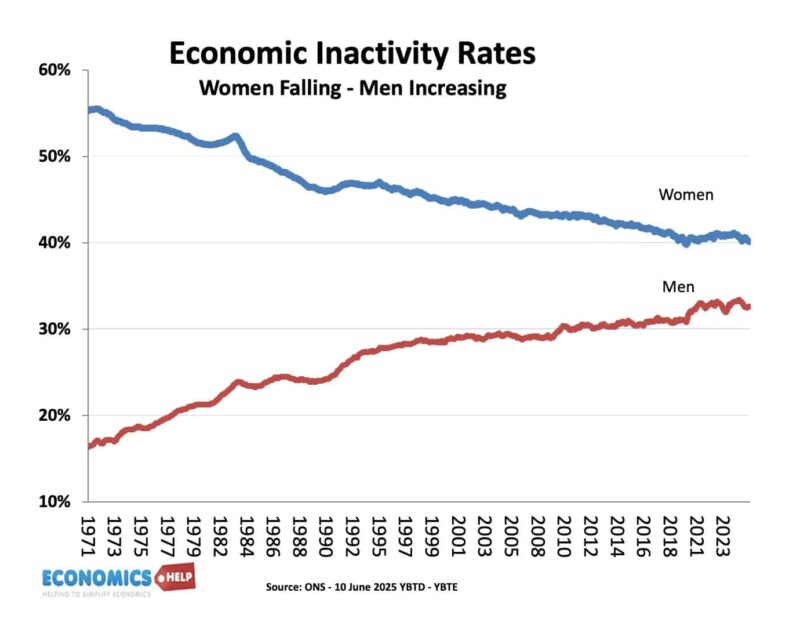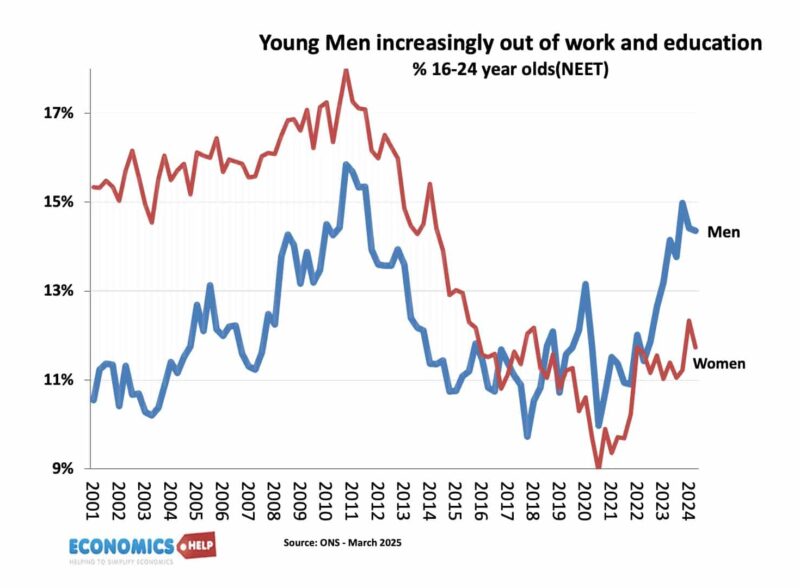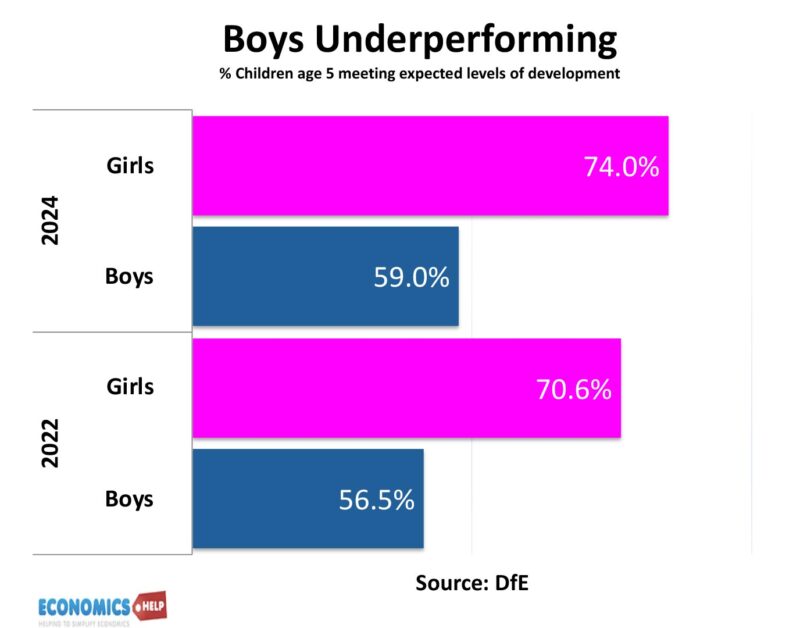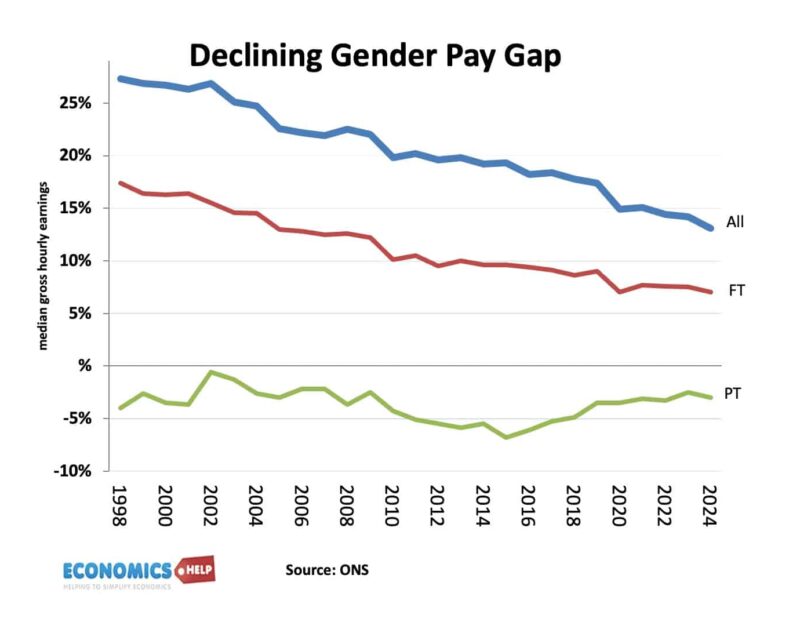Is there a crisis facing young men? In recent decades, many traditional male jobs have disappeared and this has caused a significant drop in male employment levels.

In 1970, economic inactivity rates for men were 16% today it has risen to 32%. This decline in traditional employment patterns has contributed to a growth in mental health problems and increased rates of suicide. It is not just about vibes; the data shows a clear deterioration in many outcomes. Since the pandemic, the number of men not in work, education or training has increased to worrying levels.


In education, women are now significantly outperforming men. It starts early, at the age of 5, just 59% of boys meet expected goals, compared to 74% of girls. 72% of children with special education needs are boys. GCSE pass grades are better for girls, and women are more likely to go on to university. In 2022, 54% of women were in higher education compared to only 40% of men. And this gap in educational attainment is having an impact on job prospects, especially for recent graduates. This is not just a UK phenomenon, but widespread across the world. We see similar trends in the United States with boys’ educational attainment falling behind. The OECD actually report an even bigger gender educational gap, with only 41% of men attaining tertiary education compared to 54% of women.
Reasons
One theory for poor educational attainment amongst boys is a lack of suitable role models. In 1970, 79% of children lived with both biological parents during their childhood, but today that figure has fallen to 56%, meaning more single-parent families. Boys especially, are adversely affected by a lack of a father figure. If there is not father figure at home, they are unlikely to find it at school. 85% of primary school teachers are female, and 64% of secondary school teachers. These days, young children are more likely to have a smartphone than a father at home. Whatever the reason, the statistics on crime and disorder are worrying with boys more likely to be excluded from school, and more likely to be involved in crime. In 2024, boys in youth custody outnumbered girls 529 to 11. 96% of the prison population is male, and the prison population has increased fivefold since 1960. We have become good at locking people up, but failing to address the root causes.
Social Media
To some, the rise of social media and mobile phones can be blamed with young people experiencing easier access to violent and pornographic material online. A House of Commons Youth Select Committee reported 91% of young people who perpetrated violence had recently seen violent content on social media. Although a direct link is hard to prove, knife crime amongst male youths has been a persistent problem in recent years. Not only are young men more likely to be the perpetrators of violent crime, but they are also more likely to be victims, with 90% of knife crimes being men. The problem is that the relatively higher crime rates amongst men can lead to strong negative perceptions. You can watch a tv drama like Happy Valley, and more than 80% of the men seemed to be criminal, alcoholic or seriously damaged. And it’s not always a natural reaction to feel empathy for a group which traditionally has been severely advantages. But sometimes two things can be true at the same time. Men still dominate many positions of power and wealth, but there is a growing underclass of the left behind, who feel a greater sense of disconnection than ever before.
Gender Pay Gap Still Exists

Despite declining significantly in the past 30 years the gender pay gap still exists, with male average wages 13% higher than women. However, this gap is most noticeable after the age of 40, a time when women have often taken career breaks to have children, and lost out on promotion opportunities as a result. It is also worth bearing in mind, at the very top of industry, it is men who still tend to dominate. In the FTSE top 350 firms, 95% of CEO’s are male, with only 5% female. Only 9% of the UK’s top 0.1% wealthiest people are female. At the very top of the income and wealth spectrum, men’s historical dominance still prevails. But, whilst the top 1% of men are still doing very well, what about average younger man?
Wages
The Centre for Social Justice suggests that for young people aged 16-24 female average wages are now more than £2,000 a year higher than men, a reflection of more women graduating with degrees and an economy that increasingly provides jobs in areas like health care, education and human resource professions. In the past 15 years, the number of jobs in the human resource sector has increased fourfold – a profession where 71% are women. At the same time, the biggest job losses have been in traditionally more male-dominated professions like manufacturing, mining and blue-collar vocational jobs. Manufacturing jobs have fallen from 25% in the 1970s to around 7% today. The wage gap may be greater, but the fact, men are still more likely to choose STEM subjects like math,s where there is traditionally a higher wage premium. Women are still more likely to choose caring professions and humanities subjects.
To some extent, these trends reflect improvements in women’s education and career prospects in recent decades which is a good thing, and its important to note we don’t live in a zero-sum world where women have to gain at the expense of men and vice versa. However, there are also worrying signs that some things have gotten worse for men. The biggest concern is a rise in suicide rates since the start of the millennium with 2023, the highest rate since 1999. Death by suicide is now the leading cause of death amongst men under 50 about 4 times the rate of women. In terms of other preventable deaths from alcohol and drug-related disorders, there has been a 20% rise since 2012 for those men in deprived areas. It has contributed to a widening gap in terms of life expectancy. Currently 78.8 years for males and 82.8 years for females.
So what is going on? Economic factors can only get us so far. True, the decline in many relatively good full time male employment, especially unskilled jobs, is a factor. But, there is more to it than this. The changing nature of the economy doesn’t explain educational difficulties for men, who haven’t even entered the labour market. There is the rise of a new generation of digital natives, people who are experiencing life through the prism of an electronic screen. There is reasonable evidence that this has created more of a divide between the genders than ever before. Young Men spend more hours playing computer games, watching youtube, and women tend to spend more time on platforms like Instagram. It may sound like simple generalisations, but the data does show young people spend less time socialising in person than previous generations. Even with political preferences, there is a growing gender divide.
Another factor about dating is that three quarters of women place greater emphasis on economic viability when picking partner. 75% of women say economic viability is a key factor in a partner, but only 25% of men. According to Scott Galloway one in three men under 30 has a girlfriend, but 2/3 women of the same age have a partner. What is happening is that women are dating older men with greater economic security. The net effect is that many young men of the current generation don’t have a strong sense of identity and community. In the past, it might have been religion, trade union affiliation, workmates or a stable marriage. But, many of these past attachments have fallen away, leaving a greater sense of isolation, an isolation heightened by the online world of remote connection. But, for many men in particular, this relatively greater social isolation is not a healthy force, hence the growth of more fringe movements like online conspiracy worlds or strong media personalities who give some sense of belonging.
The new world of social media has also led to very different media consumption patterns. The rise of so called toxic influencers, the self-described misogynist Andrew Tate became the most googled person in the world. The nature of the internet and self-serving algorithms is that it is very easy to end up going down dark rabbit holes.
Not to overstate
It’s important not to overstate the decline of men. In many ways, there is greater choices for men than in the past. Born in a coal mining village, you might have had very little opportunities or choices. The fact, that more women go to university isn’t per se harmful for men. If men are less interested in studying, you will probably earn more getting a skilled vocational job like a plumber than graduating with £50,000 debt and a degree in humanities. For all the talk of mental health challenges, there is much greater openeness and willingness to talk about these issues than the stiff upper lip era of the post-war period. Also, it is a mistake to get caught into constant comparison.
However, the explosion of social media as a force in society, combined with rapid economic change, has left many men and young men in particular without a sense of purpose and belonging that is important for economic and personal health. And this issue is closely related to declining birth rates and why both genders are seemingly turning their backs on having children. This video goes into more detail on this huge force changing society.
